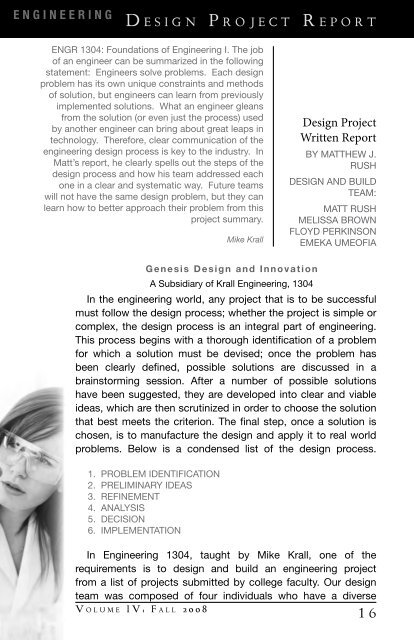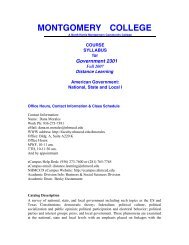2008 - Communication Across the Curriculum (CAC)
2008 - Communication Across the Curriculum (CAC)
2008 - Communication Across the Curriculum (CAC)
You also want an ePaper? Increase the reach of your titles
YUMPU automatically turns print PDFs into web optimized ePapers that Google loves.
E n g i n e e r i n g<br />
D e s i g n P r o j e c t R e p o r t<br />
ENGR 1304: Foundations of Engineering I. The job<br />
of an engineer can be summarized in <strong>the</strong> following<br />
statement: Engineers solve problems. Each design<br />
problem has its own unique constraints and methods<br />
of solution, but engineers can learn from previously<br />
implemented solutions. What an engineer gleans<br />
from <strong>the</strong> solution (or even just <strong>the</strong> process) used<br />
by ano<strong>the</strong>r engineer can bring about great leaps in<br />
technology. Therefore, clear communication of <strong>the</strong><br />
engineering design process is key to <strong>the</strong> industry. In<br />
Matt’s report, he clearly spells out <strong>the</strong> steps of <strong>the</strong><br />
design process and how his team addressed each<br />
one in a clear and systematic way. Future teams<br />
will not have <strong>the</strong> same design problem, but <strong>the</strong>y can<br />
learn how to better approach <strong>the</strong>ir problem from this<br />
project summary.<br />
Mike Krall<br />
Design Project<br />
Written Report<br />
by Mat<strong>the</strong>w J.<br />
Rush<br />
Design and Build<br />
Team:<br />
Matt Rush<br />
Melissa Brown<br />
Floyd Perkinson<br />
Emeka Umeofia<br />
Genesis Design and Innovation<br />
A Subsidiary of Krall Engineering, 1304<br />
In <strong>the</strong> engineering world, any project that is to be successful<br />
must follow <strong>the</strong> design process; whe<strong>the</strong>r <strong>the</strong> project is simple or<br />
complex, <strong>the</strong> design process is an integral part of engineering.<br />
This process begins with a thorough identification of a problem<br />
for which a solution must be devised; once <strong>the</strong> problem has<br />
been clearly defined, possible solutions are discussed in a<br />
brainstorming session. After a number of possible solutions<br />
have been suggested, <strong>the</strong>y are developed into clear and viable<br />
ideas, which are <strong>the</strong>n scrutinized in order to choose <strong>the</strong> solution<br />
that best meets <strong>the</strong> criterion. The final step, once a solution is<br />
chosen, is to manufacture <strong>the</strong> design and apply it to real world<br />
problems. Below is a condensed list of <strong>the</strong> design process.<br />
1. PROBLEM IDENTIFICATION<br />
2. PRELIMINARY IDEAS<br />
3. REFINEMENT<br />
4. ANALYSIS<br />
5. DECISION<br />
6. IMPLEMENTATION<br />
In Engineering 1304, taught by Mike Krall, one of <strong>the</strong><br />
requirements is to design and build an engineering project<br />
from a list of projects submitted by college faculty. Our design<br />
team was composed of four individuals who have a diverse<br />
V o l u m e I V : F a l l 2 0 0 8<br />
1 6






